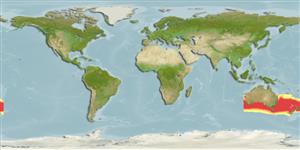Environment: milieu / climate zone / depth range / distribution range
Οικολογία
Θαλασσινό(ά); Υφάλμυρο; εύρος βάθους 22 - 500 m (Ref. 58489), usually ? - 150 m (Ref. 9072). Subtropical; 23°S - 50°S, 112°E - 176°W
Southwest Pacific: Australia and New Zealand waters. Two subpopulations probably exist in the Great Australian Bight and southeastern Australia, respectively, and two species or subspecies in the southeastern group (Ref. 7456).
Length at first maturity / Μέγεθος / Βάρος / Age
Maturity: Lm 20.0 range ? - ? cm
Max length : 50.0 cm SL αρσενικό/απροσδιόριστο; (Ref. 33839); common length : 35.0 cm TL αρσενικό/απροσδιόριστο; (Ref. 9258); μεγ. αναφερόμενη ηλικία: 25 έτη (Ref. 9072)
Ραχιαίες άκανθες (συνολικά) : 9; Μαλακές ραχιαίες ακτίνες (συνολικά) : 27 - 33; Εδρικές άκανθες: 3; Μαλακές εδρικές ακτίνες: 22 - 29; Σπόνδυλοι: 24. Adults are elongate and compressed, and have a primary lateral line with 67-81 scutes, a secondary lateral line reaching to dorsal-fin ray 2, and a yellow caudal fin.
Adults occur in coastal waters, including estuaries (Ref. 9563), mostly in waters shallower than 150 m and warmer than 13°C (Ref. 9072). Commonly found on the bottom, in midwater and occasionally at the surface (Ref. 9258), in large schools (Ref. 33616). Adults are generally found over offshore rocky reefs, while juveniles are generally found in shallow, soft substrate areas (Ref. 6390). Utilized fresh, smoked, canned and frozen; can be fried, broiled and baked (Ref. 9988).
Paxton, J.R., D.F. Hoese, G.R. Allen and J.E. Hanley, 1989. Pisces. Petromyzontidae to Carangidae. Zoological Catalogue of Australia, Vol. 7. Australian Government Publishing Service, Canberra, 665 p. (Ref. 7300)
IUCN Red List Status (Ref. 130435)
Threat to humans
Harmless
Human uses
αλιεία: Εμπορικό(ά); αλιεία αναψυχής: ναί; δόλωμα: usually
Εργαλεία
Special reports
Download XML
Διαδικτυακές πηγές
Estimates based on models
Preferred temperature (Ref.
123201): 13.1 - 21.2, mean 15.3 °C (based on 70 cells).
Phylogenetic diversity index (Ref.
82804): PD
50 = 0.5001 [Uniqueness, from 0.5 = low to 2.0 = high].
Bayesian length-weight: a=0.01778 (0.01025 - 0.03084), b=2.98 (2.84 - 3.12), in cm total length, based on LWR estimates for this species & Genus-body shape (Ref.
93245).
Τροφικό Επίπεδο (Ref.
69278): 3.2 ±0.40 se; based on food items.
Generation time: 3.7 ( na - na) years. Estimated as median ln(3)/K based on 2
growth studies.
Ελαστικότητα (Ref.
120179): Μεσαίο(α), ελάχιστος χρόνος για διπλασιασμό πληθυσμού 1,4 - 4,4 έτη (K=0.30; tm=3-4; tmax=25).
Fishing Vulnerability (Ref.
59153): Moderate vulnerability (37 of 100).
Nutrients (Ref.
124155): Calcium = 263 [161, 434] mg/100g; Iron = 3.76 [2.23, 6.42] mg/100g; Protein = 19.8 [19.0, 20.5] %; Omega3 = 0.383 [0.249, 0.578] g/100g; Selenium = 26.8 [14.7, 49.8] μg/100g; VitaminA = 8.05 [2.13, 29.13] μg/100g; Zinc = 2.37 [1.72, 3.33] mg/100g (wet weight);
